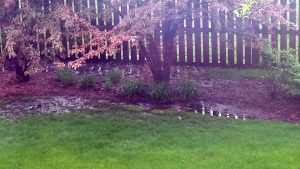Spring 2016 in the Naperville area has been cool and filled with rain! While the trees are bursting and the  grass is a beautiful shade of emerald, all of this rain is highlighting any drainage problems we have in our backyards. Do you have standing water in parts of your yard? Is it impossible to mow the grass? Do you hesitate to spend time in parts of your yard because of “swampy” conditions? The cause could very well be a drainage problem. It’s not a lost cause or something you need to live with. Several options are available to help eliminate the problem, and many offer design ideas that will enhance your outdoor space at the same time.
grass is a beautiful shade of emerald, all of this rain is highlighting any drainage problems we have in our backyards. Do you have standing water in parts of your yard? Is it impossible to mow the grass? Do you hesitate to spend time in parts of your yard because of “swampy” conditions? The cause could very well be a drainage problem. It’s not a lost cause or something you need to live with. Several options are available to help eliminate the problem, and many offer design ideas that will enhance your outdoor space at the same time.
Why does the problem exist?
Poor grading or poor soil or a combination may be the cause. Clay soil is difficult to drain properly, and adding organic matter such as compost, peat moss or composted manure will help the problem. Proper grading, including a gentle slope away from your home, will cause the water to drain away, but sometimes the water can pool in the far end of your yard as a result.
How to solve the problem:
A French drain, which will direct water from your downspouts away from your house, will help to divert water away from your home. If it all empties into one area of the yard, however, it might take several days for it to drain away, especially if you have soil with a high clay content. Adding a dry well in the area of the yard where the French drain ends will give the water a place to collect. The well allows the water to disperse into the soil over time. Using these two techniques will result in much faster water drainage.
Plant water-loving species. This is a good solution for areas that remain wet and spongy after a rain, but not necessarily where you have standing water for days. The Northern Virginia Soil and Water Conservation District says, “A soggy spot can be improved by replanting with water-tolerant plants. Plants will aesthetically improve the soggy spot, soak up the remaining water, attract beneficial pollinators, and they can also slowly improve drainage by loosening the soil with their roots and organic matter.” Several shrubs, trees and perennials are available that thrive in poorly drained soils in northern Illinois.
Consider adding a dry creek bed to the back of your yard. Dry creek beds direct excess water away from your grass while adding beauty and interest to your landscaping. Dry creek beds are a series of rocks and pebbles that resemble a curvy stream, and are placed over wet areas, usually in the back of a yard. With the addition of small bridges, lighting and other decorative touches, a dry creek bed is a beautiful and practical solution to a standing water problem.
If the problem is in a corner of the yard or a small area, planting a tree might be the solution. Trees suited for wet areas, and planted correctly (not too deep), will drink up excess moisture while adding shade and interest to your yard. Many maples, varieties of oak, river birch, and others are good choices. A trusted landscape designer can recommend the right tree for your landscape.
O’Donovan Landscaping will provide expert design advice and professional installation services for your outdoor landscaping. With over 45 years of experience, we have a proven track record of satisfied customers in Naperville and surrounding suburbs. Call us at 630-355-3370 to find out how we can help you make your outdoor landscape welcoming and beautiful for years of enjoyment.









